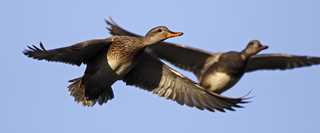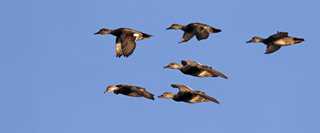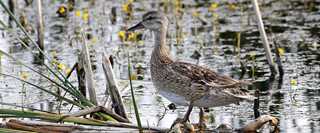Photo Essay: The Gadwall
North America's most inconspicuous dabbling duck
North America's most inconspicuous dabbling duck
The gadwall may be North America's most inconspicuous dabbling duck. Drakes have mainly gray and brown body plumage, a solid black rump, and a white belly. Their wings are marked with a black and white speculum and maroon shoulder patch. Hens are even more nondescript, having dull brown body plumage and a white belly.

Photo Michael Furtman
Female gadwalls also have a white bar on their speculum but lack the other wing markings displayed by males. Perhaps the most recognizable thing about gadwalls is their voice. Females make a soft, raspy quack similar to hen mallards, but males emit a distinctive kack, kack-kack punctuated by a low whistle. This call is remarkably loud and will carry long distances through the air or across the water.

Photo Michael Furtman
Like mallards, pintails, and shovelers, gadwalls breed throughout the northern hemisphere, including North America, Europe, and Asia. In this continent, gadwalls have a widespread breeding range stretching from Alaska to eastern Canada to California, but the overwhelming majority of the population breeds in the Prairie Pothole Region of the United States and Canada.
Most gadwalls migrate in the Central and Mississippi flyways, with smaller numbers following the Atlantic and Pacific flyways. Gadwalls winter throughout southern portions of each flyway, but the majority of the continental population winters in Louisiana.

Photo Michael Furtman
Large numbers of wintering gadwalls also gather in Texas, Mississippi, Arkansas, the Carolinas, and California. Gadwalls eat a largely vegetarian diet consisting of aquatic vegetation and seeds found in shallow wetlands. As a result, gadwalls generally migrate earlier than mallards and divers that feed in dry fields or deeper waters.

Photo Michael Furtman
As gadwall numbers have soared in recent decades, they have become an increasingly important part of the waterfowl harvest in many states. In fact, gadwalls are often the third most commonly harvested duck in the United States behind mallards and green-winged teal.
Learn more about the gadwall
Ducks Unlimited uses cookies to enhance your browsing experience, optimize site functionality, analyze traffic, and deliver personalized advertising through third parties. By continuing to use this site, you agree to our use of cookies. View Privacy Policy